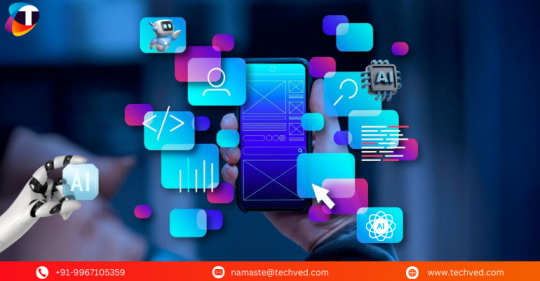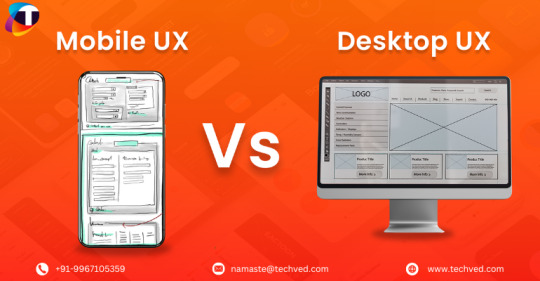Don't wanna be here? Send us removal request.
Text
AI and Data Analytics: Revolutionizing UI/UX Design
In today's fast-paced digital world, user experience is paramount. To create seamless and engaging digital interfaces, businesses are increasingly turning to AI and data analytics. By harnessing the power of these technologies, designers can gain deeper insights into user behavior, personalize experiences, and iterate rapidly.

The Synergy of AI and Data Analytics in UI/UX
The integration of AI and data analytics has transformed the landscape of UI/UX design. By analyzing vast amounts of data, AI-powered tools can uncover valuable insights into user preferences, pain points, and trends. These insights empower designers to create more intuitive, personalized, and effective user interfaces.
Key Benefits of AI and Data Analytics in UI/UX
Data-Driven Insights:
Predictive Analytics in Business: By leveraging AI, businesses can anticipate user needs and preferences, allowing for proactive design decisions.
AI-Driven Business Decisions: Data-driven insights enable informed choices that optimize user experiences.
Personalized Experiences:
AI Data Analysis for Business: By segmenting users based on their behavior and preferences, designers can tailor experiences to individual needs.
Generative AI for Business: AI-powered tools can generate personalized recommendations, content, and interface elements.
Accelerated Design Processes:
Data Analytics Automation with AI: Automated data analysis and insights streamline the design process, reducing time-to-market.
AI-Powered Prototyping: AI-driven tools can rapidly generate multiple design prototypes, facilitating rapid iteration.
Enhanced Accessibility:
AI-powered tools can help identify and address accessibility issues, ensuring inclusive designs for all users.
The Future of UI/UX Design
As AI and data analytics continue to evolve, the future of UI/UX design looks promising. By embracing these technologies, businesses can create digital experiences that are not only visually appealing but also highly functional and user-centric.
Key Takeaways:
AI and data analytics are revolutionizing UI/UX design.
Data-driven insights are essential for creating effective user experiences.
AI-powered tools can accelerate design processes and improve efficiency.
Personalized experiences are key to user engagement and satisfaction.
Accessibility is a critical aspect of modern UI/UX design.
By staying ahead of the curve and leveraging the power of AI and data analytics, businesses can deliver exceptional digital experiences that drive user satisfaction and business success.
0 notes
Text
#Cybersecurity#AI in Cybersecurity#Threat Detection with AI#Cybersecurity and Artificial Intelligence#Future of Cybersecurity#Real-Time Cyber Threat Analysis#Cybersecurity Data Analysis
0 notes
Text
#data analytics and ai#data analytics and bi#data analytics with ai#ai in data analytics#AI in Business Intelligence#data analytics services
0 notes
Text
How AI and Data Analytics Shape Smarter Business Decisions
Companies harnessing AI and data analytics have a clear advantage, making decisions five times faster and more accurately. Rather than following trends, top businesses leverage hidden data insights to anticipate and even shape customer desires before they are expressed. By identifying market shifts in real-time, AI enables businesses to create precise strategies and secure a competitive edge that drives growth and innovation.

AI and Data Analytics: The Dynamic Duo for Business Success
Integrating data analytics with AI has transformed business intelligence, enabling companies to derive actionable insights from complex data. Traditional data analytics focused on identifying trends from historical data, but AI takes this a step further, adding predictive power and automating intricate data-driven processes. Together, they help companies not only look backward but also anticipate what lies ahead.
AI-driven data analytics empowers businesses to forecast trends and automate decisions based on current and historical data, helping companies streamline operations and refine their strategic planning. From personalized marketing to optimizing supply chains, AI enhances the accuracy and depth of business intelligence, making it invaluable for organizations across all sectors.
Data Analytics and Business Intelligence: A Core Asset for Companies
Data analytics and business intelligence (BI) tools have evolved from basic data processing into crucial tools for everything from risk management to enhancing customer experiences. By transforming raw data into valuable insights, BI enables faster, more informed decision-making. Merging AI with BI allows companies to analyze real-time data, revealing patterns and trends beyond human capability.
Moreover, data analytics services provide scalable solutions that help businesses stay competitive in a dynamic marketplace. AI-powered BI tools can now process massive data volumes, delivering deep insights rapidly, transforming the way industries operate and adapt.
Predictive Analytics: Future-Forward Business Strategies
Predictive analytics enables companies to forecast customer behaviors, industry trends, and operational needs. By analyzing historical data and applying machine learning, businesses can anticipate shifts and implement optimized processes, reducing risks. For instance, in retail, predictive analytics helps forecast seasonal product demand, minimizing stock issues. In manufacturing, it allows for early detection of equipment failures, saving costs related to downtime and maintenance. By embedding predictive models, businesses gain precision in decision-making, fueling proactive strategies.
Generative AI for Business: Unlocking New Possibilities
Generative AI is revolutionizing how companies create content, design products, and engage with customers. Using existing datasets, generative AI creates new data that enhances product simulations, tailors content, and inspires innovative product designs. In the financial sector, AI powers advanced customer services, fraud detection, and risk management. For instance, AI-powered chatbots and virtual assistants have become standard in banking, while machine learning models strengthen fraud detection.
Through AI-driven data analytics, financial institutions can now assess loans more accurately, enhancing customer satisfaction and operational efficiency. Personalized offerings, customer preference tracking, and regulatory responsiveness are just a few ways AI helps banks stay agile and customer-focused.
Key Advantages of AI and Data Analytics in Business
Enhanced Decision-Making: AI and data analytics allow companies to make fast, informed choices using real-time data, improving efficiency and competitiveness.
Operational Efficiency: By automating repetitive tasks, AI-powered analytics minimizes errors, freeing teams to focus on high-value initiatives.
Personalized Customer Experiences: With predictive analytics and generative AI, companies can tailor offerings to individual preferences, boosting engagement and loyalty.
Cost Savings: Predictive maintenance powered by AI reduces downtime and maintenance expenses.
Risk Management: Real-time risk analysis helps companies identify and address threats proactively.
The Future of AI and Data Analytics in Business
As AI technology advances, so will its applications in business. Natural Language Processing (NLP) and machine learning are expanding business capabilities, allowing for real-time feedback and customer sentiment analysis from social media and service calls. This enables companies to adapt strategies dynamically.
Conclusion
Integrating AI and data analytics is not just about adopting new technology—it’s reshaping business practices and unlocking a data-driven future. Businesses that invest in these technologies now will be well-prepared for future challenges and opportunities, staying ahead of competitors. Explore the potential of AI-driven analytics to revolutionize your business and secure a smarter, more resilient future.
#data analytics and ai#data analytics and bi#data analytics with ai#ai in data analytics#AI in Business Intelligence#data analytics services
0 notes
Text
#ui/ux#ui/ux design#ux design#ROI of UI/UX#UI UX Case study#Website design#User Experience (UX)#web development#website UI UX
0 notes
Text
#AI#AI chatbot#AI and Workforce#ai development services#AI in Banking#AI automation testing#AI and economic growth#AI in Healthcare
0 notes
Text
The Multi-Screen Challenge: Mastering User Experience Across Devices
The digital landscape is a battlefield of screens – phones, tablets, and desktops – each demanding a unique user experience (UX) strategy. Today's savvy customers expect flawless, engaging interactions no matter which device they choose. This blog delves into the complexities of crafting a winning UX for both mobile and desktop environments.

The Two Faces of UX: Speed vs. Depth
Mobile users crave lightning-fast loading times and intuitive navigation. Studies show over half abandon a mobile site if it takes more than 3 seconds to load. This means prioritizing minimalism and eliminating clutter to keep users engaged. Responsive web design ensures layouts adapt to different screen sizes, delivering an optimal experience on any device.
On the desktop, the focus shifts to depth and complexity. Users expect interfaces to handle intricate tasks like data analysis or complex online shopping with multiple tabs open. Desktop UX should facilitate easy information architecture and seamless integration with other tools and services.
Emerging Trends to Watch
Mobile:
Microinteractions: Subtle animations enhance the experience without overwhelming users. This could be simple feedback, guiding users, or creating a delightful micro-moment.
Voice User Interface (VUI): As voice assistants like Siri and Google Assistant become ubiquitous, mobile designs are increasingly incorporating voice-activated controls.
Gestural Navigation: Swipes, taps, and pinches replace traditional buttons for a more immersive and intuitive interaction.
Desktop:
Dark Mode: This is beyond a trend; it's a user preference. Dark themes are easier on the eyes for extended periods, making them ideal for desktop use.
AI-powered personalization: Artificial intelligence tailors layouts, content, and features based on user behavior and preferences. This creates a truly personalized user experience.
Advanced Keyboard Shortcuts: Enhanced shortcuts improve productivity by reducing unnecessary clicks and streamlining workflows.
Bridging the Divide: A Seamless Multi-Device Experience
The future of UX lies in creating harmonious yet platform-specific experiences. Here are some strategies to embrace:
Responsive vs. Adaptive Design: Responsive design ensures content adjusts for different screens. Adaptive design takes it a step further, creating layouts specifically tailored to each device type (mobile or desktop), resulting in a more "native" feel.
Fast-tracking and Cross-Platform Functionality: Imagine picking up where you left off on a Google Doc or Slack app, regardless of your device. This seamless cross-platform functionality enhances productivity and user engagement.
User-Centric Design at its Core: Whether mobile or desktop, user-centric design is paramount. Analyze user interactions with the product across devices and iterate based on that data. This ensures users always have a positive experience.
Progressive Web Apps (PWAs): These combine the best of both worlds, delivering app-like experiences within a web browser. PWAs provide a smooth experience regardless of device, eliminating the need for separate apps.
Winning the Multi-Device UX War: Your Roadmap to Success
Invest in Data-Driven Design: Understand user demographics and how they interact with your platform across devices. Data should inform every design decision.
Prioritize Different Performance Metrics: Mobile UX emphasizes speed and minimalism, while desktop focuses on richer content and deeper engagement capabilities. Optimize for each platform's unique requirements.
Embrace New Technologies: Leverage AI, machine learning, and automated UI optimization to personalize user experiences. These technologies can personalize and optimize websites for various devices, preferences, and contexts, boosting engagement across all platforms.
Conclusion:
Forget the "mobile vs. desktop" debate. The real winner is the company that delivers a seamless, user-centric experience across all devices. By understanding your audience's needs and adapting your UX strategy accordingly, you can cultivate loyal users and unlock the full potential of your multi-screen presence. Ready to create a winning multi-device UX strategy? Contact us today!
1 note
·
View note